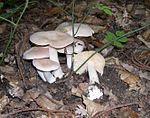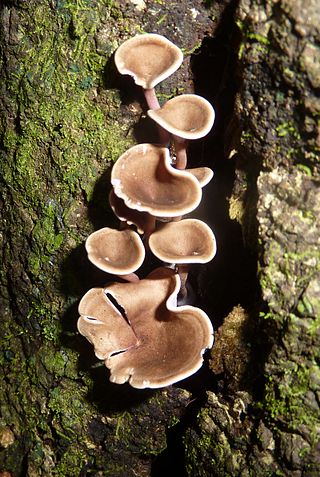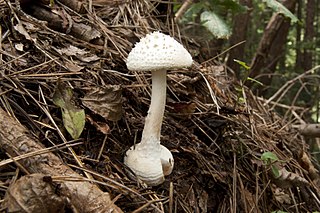Fungi with significant risk of death if consumed
| Scientific name | Common name | Active Agent | Toxicity | Habitat | Similar edible species | Picture |
|---|---|---|---|---|---|---|
| Amanita arocheae Tulloss, Ovrebo & Halling | Latin American death cap | amanitins | liver | Woodland (oak) Mexico |  | |
| Amanita bisporigera G. F. Atk. | Eastern destroying angel | amanitins | liver | Woodland (pine and oak) Eastern North America | Agaricus silvicola , Volvariella volvacea |  |
| Amanita exitialis Zhu L. Yang & T.H. Li | Guangzhou destroying angel | amanitins [1] [2] | liver | Deciduous woodland Guangdong province, China; India | ||
| Amanita fuliginea Hongo | East Asian brown death cap | amanitins | liver | Woodland China |  | |
| Amanita magnivelaris Peck | Great felt skirt destroying angel | amanitins [3] | liver | Americas |  | |
| Amanita ocreata Peck | Western destroying angel | amanitins | liver | Woodland (oak) Pacific Northwest North America |  | |
| Amanita phalloides (Vaill. ex Fr.) Link | death cap | amanitins | liver | Woodland (various) Europe, North Africa, North America, Australia (SE), New Zealand | Volvariella volvacea , Russula virescens Amanita lanei Tricholoma equestre, Agaricus campestris |  |
| Amanita smithiana Bas | smith's lepidella | 2-amino-4,5-hexadienoic acid | liver & kidney | Woodland Japan and Pacific Northwest |  | |
| Amanita sphaerobulbosa Hongo | Asian abrupt-bulbed Lepidella | 2-amino-4,5-hexadienoic acid | liver & kidney | Mixed woodlands, eastern Asia |  | |
| Amanita subpallidorosea Qing Cai, Zhu L. Yang & Y.Y. Cui | amanitins | liver | Woodland China | |||
| Amanita subjunquillea S. Imai | East Asian death cap | amanitins | liver | Woodland East and Southeast Asia, Japan, India |  | |
| Amanita verna (Bull.: Fr.) Lam. | Fool's mushroom | amanitins | liver | Woodland (various) Europe | Agaricus arvensis Agaricus campestris Lycoperdon spp. |  |
| Amanita virosa (Fr.) Bertillon | European destroying angel | amanitins | liver | Woodland (various) Europe | Agaricus arvensis Agaricus campestris Lycoperdon spp. |  |
| Claviceps purpurea | Ergot | ergotamine | multiple | grass |  | |
| Clitocybe dealbata (Sowerby) Gillet | ivory funnel | muscarine | CNS | grassland Europe, North America | Marasmius oreades |  |
| Clitocybe rivulosa (Pers.) P. Kumm. | false champignon | muscarine | CNS | grassland Europe, North America | Marasmius oreades |  |
| Cortinarius orellanus Fries | Fool's webcap | orellanine | kidney | Coniferous woodland Northern Europe |  | |
| Cortinarius rubellus Cooke | deadly webcap | orellanine | kidney | Coniferous woodland Northern Europe |  | |
| Cortinarius eartoxicus Gasparini | deadly webcap | orellanine | kidney | Tasman Peninsula, Tasmania | ||
| Cortinarius splendens Rob. Henry | splendid webcap, yellow clubbed foot | orellanine | kidney |  | ||
| Galerina marginata (Batsch) Kühner | autumn skullcap | amanitins | liver | worldwide | Kuehneromyces mutabilis |  |
| Galerina sulciceps (Batsch) Kühner | toadstool | amanitins | liver | Indonesia | ||
| Gyromitra esculenta (Pers. ex Pers.) Fr. | false morel | gyromitrin and monomethylhydrazine | multiple (depletes PLP stores) | Coniferous woodlands in the Northern hemisphere | Morchella spp. |  |
| Inosperma erubescens (A. Blytt) Matheny & Esteve-Rav. | red-staining inocybe (prev. I. patouillardii) | muscarine | CNS | Deciduous woodland (beech) Europe | Calocybe gambosa , Agaricus spp., Cortinarius caperatus [4] |  |
| Lepiota brunneoincarnata Chodat & C. Martín | deadly dapperling | amanitins | liver | Coniferous woodland Europe | Tricholoma terreum , Marasmius oreades | 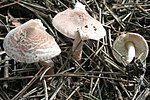 |
| Lepiota brunneolilacea Bon & Boiffard | star dapperling | amanitins | liver | Sand dunes of Western Europe | ||
| Lepiota castanea Quél | chestnut dapperling | amanitins | liver | Coniferous woodland Europe | 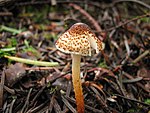 | |
| Lepiota helveola Bres. | amanitins | liver | Coniferous woodlands of Europe |  | ||
| Lepiota subincarnata | deadly parasol | amanitins | liver | Asia, Europe, and North America |  | |
| Pholiotina rugosa (Peck) Singer more commonly known as Conocybe filaris | amanitins | liver | grassland, lawns, rich soil and compost North America, Europe and Asia | Psilocybe spp. |  | |
| Podostroma cornu-damae (Patouillard) Hongo & Izawa | poison fire coral | diacetyl satratoxin-H (ribosome inactivating small molecule) | bone marrow, brain and skin | Japan, South Korea, Papua New Guinea, Australia | Ganoderma |  |
| Paxillus involutus (Batsch ex Fr.) Fr. | brown roll-rim | unknown, possibly glycoprotein antigen | extreme autoimmune reaction with hemolysis | Europe and North America |  | |
| Trogia venenata Zhu L.Yang, Y.C.Li & L.P.Tang | Little White | (2S,4R)‐2‐amino‐4‐hydroxyhex‐5‐ynoic acid [5] | Causes cardiac arrhythmia and hypoglycemia (Yunnan Sudden Death Syndrome) | Yunnan, China | white Pleurotus |


